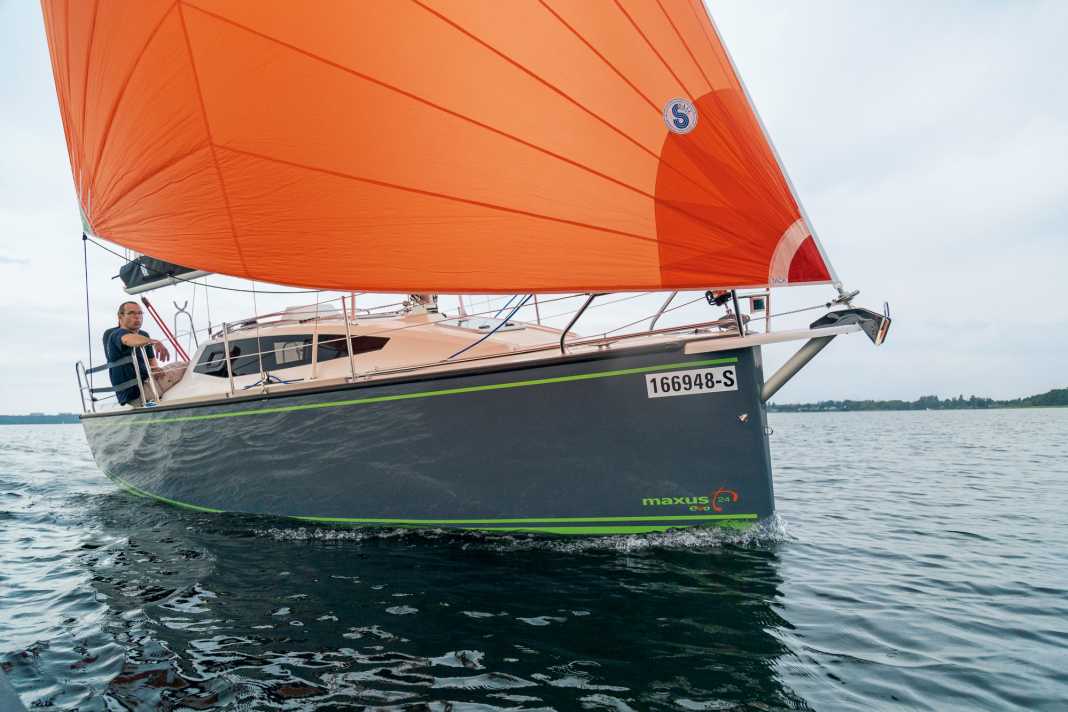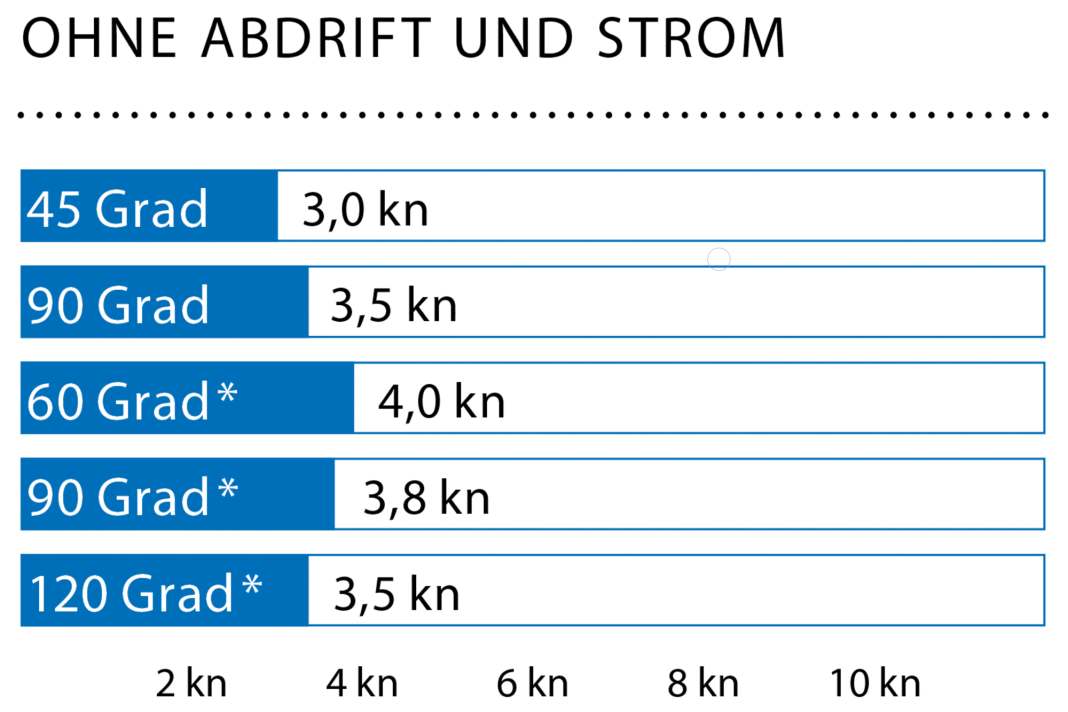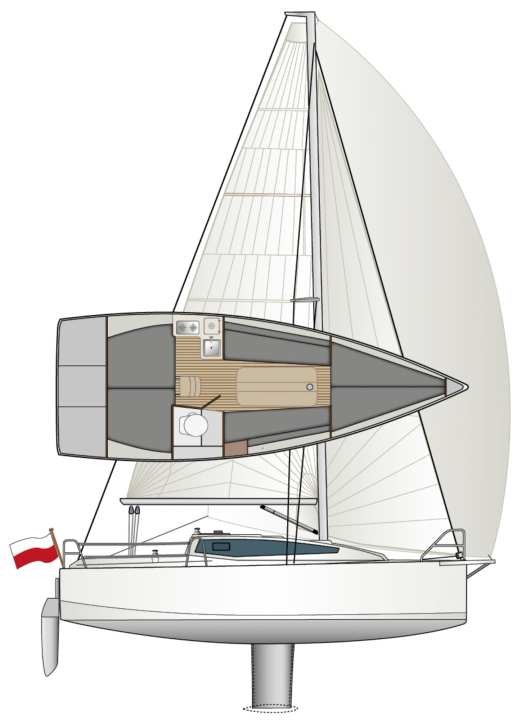





The electric outboard pushes the Maxus 24 Evo out onto Lake Schwerin, the castle gleams golden aft and the water in front of the bow is as smooth as glass. Not a breath ripples the surface of the Mecklenburg-Vorpommern inland waters.
The only difference between the new 24 from the Polish Northman shipyard and its predecessor is the Evo suffix for Evolution. But the further development is also easy to recognise visually: Thanks to the 35 centimetre lengthening, the striking kinks in the hull and the less spherical superstructure, the new design looks more modern and not clumsy despite the high freeboard. The increase in length also results in a higher weight. At 2.1 tonnes, the Maxus 24 Evo weighs 400 kilograms more than its predecessor. However, it also has three square metres more sail area on the wind. The four keel variants with centreboard (standard), lifting keel, fixed keel and twin keels are special.
Externally, there are strong similarities to the Antila 24.4 (test in YACHT 13/2017). This is no coincidence, as both designs were created by the same designer. However, the Antila is 15 centimetres wider and therefore offers even more volume.
Light wind sailing
A few dark patches in the mirror-smooth water and an approaching wall of cloud give us hope for wind. And indeed, together with a fine drizzle, a light breeze sets in. The outboard motor is raised and the sails are set. With 19 square metres in the mainsail and a slightly overlapping genoa of 11 square metres, the Maxus reaches a speed of 3, sometimes even 3.5 knots. With just 4 to 5 knots of true wind, these are good figures.
With 45 degrees to the wind, the height is also right, but especially in such light winds, a small shake in the sheets makes the difference between 3 and 3.5 knots. The small boat steers agilely and also goes well through the wind. For 1335 euros, the boatyard offers a flat-cut room wind sail with furling system and anti-torsion cable. The furler, which is very reminiscent of a Bartels product, works very well, and the approximately 25 square metres provide more than twice as much headsail area.
Also interesting:
In these conditions, this makes a difference of half a knot to a whole knot more speed. Up to 60 degrees of height are possible with the flat sail, which the shipyard calls a drifter. And thanks to the uncomplicated furling, even tacking is no problem. Afterwards, it is simply rolled out again. With a speed of 4 knots, the boat comes very close to the wind speed measured at 6 knots.
The cockpit is well organised. The winches are easily accessible when sitting on the dinghy or the coaming. There is plenty of space for fellow sailors on the 1.90 metre long dents. As these are not flush with the open stern, there is still room for your feet when operating the outboard motor.
Halyards, outhaul and reefing lines are redirected aft to the superstructure roof under the sprayhood. High-quality fittings are included as standard: The winches are from Andersen, ten as standard, twelve and self-tailing for an extra charge, the halyard stoppers are from Spinlock, travellers and blocks are from Ronstan and the ropes are from Gleistein. The Raymarine instruments are also very practical. The displays in the TackTick series are wireless and are self-powered by small solar cells. The wind sensor, log and plumb bob send their signals to a small black box in the ship, which in turn transmits the data to the displays. This saves on cabling, and the displays can also be easily removed and stowed away, which protects against premature ageing and theft. However, the instrument system also costs an extra 2166 euros. The Furlex for the genoa and the halyard stoppers add another 500 euros.
Small flat
The layout below deck is classic: next to the companionway steps on the port side is a small, L-shaped galley with a two-burner spirit cooker, fridge, sink and storage space. On the starboard side, there is an enclosed toilet room for an extra 1428 euros, which is easy to use with an area of 54 x 45 centimetres in front of the toilet and a height of 1.74 metres. However, the toilet also costs extra; the cheapest option is the chemical toilet for 235 euros. There are benches on both sides of the saloon and the base of the fold-out table houses the centreboard box. The forward berth area is not partitioned off, so you can sit on the berth cushion at the head of the large saloon table.
With a length of 2.07 metres and a shoulder width of 1.44 metres, the bunk is a good size; only the footwell is a little tight at 22 centimetres. The bunk under the cockpit is installed at right angles to the direction of travel; it also measures an impressive 2.05 metres in length, but is slightly narrower at 1.20 metres wide. However, this space is also available in the footwell. At 1.88 metres long and a narrow 70 centimetres wide, the saloon benches only offer space for children.
The interior finish is good, apart from some not so nicely applied edge finishes
There is plenty of storage space under the saloon benches, which are part of the inner shell. Thanks to the folding cushions and spiral springs that hold the lid up, they are also easy to reach. The next largest storage space is located aft behind the sleeping area. In addition to the enormous size of twice 80 x 90 x 50 centimetres, the neatly top-coated surfaces are particularly striking. This is not a matter of course. The interior fittings are good, apart from some of the edge finishes, which are not so neat. The surfaces are made of HPL plastic and don't look bad.
At 132 centimetres long, the superstructure windows allow plenty of light into the interior; air can also circulate through two hatches at the top and a small one above the galley, aft berth and in the toilet room. However, the latter three are an option and together cost an extra 970 euros.
Sailors who want a high level of living comfort and also order a few extras for the fittings can easily end up paying 10,000 euros more than the boatyard price. However, this is not unusual in this segment and is understandable as (apart from the drifter's furling system) brand fittings, instruments and installations are used throughout.
Overall, the Maxus 24 Evo is a very successful compromise between living comfort, good sailing characteristics and a fair price. There are also four possible attachments that make the boat attractive for different sailing areas.
The measured values for testing the Maxus 24 Evo




The Maxus 24 Evo in detail

Technical data of the Maxus 24 Evo
- Designer: Jacek Daszkiewicz
- CE design category: C
- Torso length: 7,35 m
- Width: 2,55 m
- Draught/alternative: 1,35-0,32/1,76 m
- Weight: 2,1 t
- Ballast/proportion: 0,595 t/28,3 %
- Mainsail: 19 m2
- Furling genoa (105 %): 11 m2
- machine (epropulsion): 1 kW/3 hp
Hull and deck construction
Full laminate by hand with polyester resin (hull), sandwich with foam core (deck)
Price and shipyard
- Base price ex shipyard: 48,700 € gross incl. VAT.
- Guarantee/against osmosis: 2/2 years
As of 05/2024, how the prices shown are defined can be found here!
Shipyard
Northman Yachts, Wegorzewo, www.northman.pl
Distribution
Sportboothandel Johannsen, www.maxus-yachten.de
YACHT review of the Maxus 24 Evo
The Maxus 24 Evo is designed as a touring boat for inland cruises with the family. The small cruiser fully lives up to this claim. A successful compromise between space and sailing characteristics
Design and concept
- + Modern lines, pleasing appearance
- + High dimensional stability
- + Four keel variants
Sailing performance and trim
- + Good light winch properties
- + Practical layout
Living and finishing quality
- + Great sense of space
- + Separate WC room
- - Edge banding partly not glued properly
Equipment and technology
- + High-quality winches and fittings
- + River hatches
- + Drifter at a fair price
The article first appeared in YACHT 22/2017 and has been updated for the online version.

